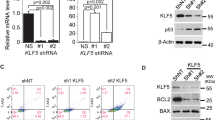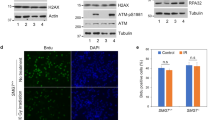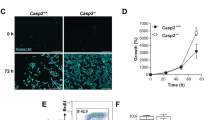Abstract
Response to genotoxic stress can be considered as a multistage process involving initiation of cell-cycle arrest and maintenance of arrest during DNA repair1. Although maintenance of G2/M checkpoints is known to involve Chk1, Chk2/Rad53 and upstream components, the mechanisms involved in its initiation are less well defined1,2,3,4. Here we report that p38 kinase has a critical role in the initiation of a G2 delay after ultraviolet radiation. Inhibition of p38 blocks the rapid initiation of this checkpoint in both human and murine cells after ultraviolet radiation. In vitro, p38 binds and phosphorylates Cdc25B at serines 309 and 361, and Cdc25C at serine 216; phosphorylation of these residues is required for binding to 14-3-3 proteins. In vivo, inhibition of p38 prevents both phosphorylation of Cdc25B at serine 309 and 14-3-3 binding after ultraviolet radiation, and mutation of this site is sufficient to inhibit the checkpoint initiation. In contrast, in vivo Cdc25C binding to 14-3-3 is not affected by p38 inhibition after ultraviolet radiation. We propose that regulation of Cdc25B phosphorylation by p38 is a critical event for initiating the G2/M checkpoint after ultraviolet radiation.
This is a preview of subscription content, access via your institution
Access options
Subscribe to this journal
Receive 51 print issues and online access
$199.00 per year
only $3.90 per issue
Buy this article
- Purchase on Springer Link
- Instant access to full article PDF
Prices may be subject to local taxes which are calculated during checkout




Similar content being viewed by others

References
Pines, J. Four-dimensional control of the cell cycle. Nature Cell Biol. 1, E73–E79 (1999).
Peng, C. Y. et al. Mitotic and G2 checkpoint control: regulation of 14-3-3 protein binding by phosphorylation of Cdc25C on serine-216. Science 277, 1501–1505 (1997).
Furnari, B., Rhind, N. & Russell, P. Cdc25 mitotic inducer targeted by chk1 DNA damage checkpoint kinase. Science 277, 1495–1497 (1997).
Hirao, A. et al. DNA damage-induced activation of p53 by the checkpoint kinase Chk2. Science 287, 1824–1827 (2000).
Hollander, M. C. et al. Genomic instability in Gadd45a-deficient mice. Nature Genet. 23, 176–184 (1999).
Sanchez, Y. et al. Conservation of the Chk1 checkpoint pathway in mammals: linkage of DNA damage to Cdk regulation through Cdc25. Science 277, 1497–1501 (1997).
Nilsson, I. & Hoffmann, I. Cell cycle regulation by the Cdc25 phosphatase family. Prog. Cell Cycle Res. 4, 107–114 (2000).
Gabrielli, B. G., Clark, J. M., McCormack, A. K. & Ellem, K. A. Ultraviolet light-induced G2 phase cell cycle checkpoint blocks cdc25- dependent progression into mitosis. Oncogene 15, 749–758 (1997).
Karlsson, C., Katich, S., Hagting, A., Hoffmann, I. & Pines, J. Cdc25B and Cdc25C differ markedly in their properties as initiators of mitosis. J. Cell. Biol. 146, 573–584 (1999).
Lammer, C. et al. The cdc25B phosphatase is essential for the G2/M phase transition in human cells. J. Cell Sci. 111, 2445–2453 (1998).
Liu, Z. G. et al. Three distinct signalling responses by murine fibroblasts to genotoxic stress. Nature 384, 273–276 (1996).
Jiang, Y. et al. Characterization of the structure and function of the fourth member of p38 group mitogen-activated protein kinases, p38δ. J. Biol. Chem. 272, 30122–30128 (1997).
Lee, J. C., Kassis, S., Kumar, S., Badger, A. & Adams, J. L. p38 mitogen-activated protein kinase inhibitors—mechanisms and therapeutic potentials. Pharmacol. Ther. 82, 389–397 (1999).
Bulavin, D. et al. Phosphorylation of human p53 by p38 kinase coordinates N-terminal phosphorylation and apoptosis in response to UV radiation. EMBO J. 18, 6845–6854 (1999).
Poon, R. Y. C., Jiang, W., Toyoshima, H. & Hunter, T. Cyclin-dependent kinases are inactivated by a combination of p21 and Thr-14/Tyr-15 phosphorylation after UV-induced DNA damage. J. Biol. Chem. 271, 13283–13291 (1996).
Yaffe, M. B. et al. The structural basis for 14-3-3:phosphopeptide binding specificity. Cell 91, 961–971 (1997).
Lopez-Girona, A., Furnari, B., Mondesert, O. & Russell, P. Nuclear localization of Cdc25 is regulated by DNA damage and a 14-3-3 protein. Nature 397, 172–175 (1999).
Morris, M. C., Heitz, A., Mery, J., Heitz, F. & Divita, G. B. An essential phosphorylation-site domain of human CDC25C interacts with both 14-3-3 and cyclins. J. Biol. Chem. 275, 28849–28857 (2000).
Graves, P. R. et al. The Chk1 protein kinase and the Cdc25C regulatory pathways are targets of the anticancer agent UCN-01. J. Biol. Chem. 275, 5600–5605 (2000).
Liu, Q. et al. Chk1 is an essential kinase that is regulated by Atr and required for the G2/M DNA damage checkpoint. Genes Dev. 14, 1448–1459 (2000).
Blasina, A. et al. A human homologue of the checkpoint kinase Cds1 directly inhibits Cdc25 phosphatase. Curr. Biol. 9, 1–10 (1999).
Liu, F., Rothblum-Oviatt, C., Ryan, C. E. & Piwnica-Worms, H. Overproduction of human Myt1 kinase induces a G2 cell cycle delay by interfering with the intracellular trafficking of Cdc2-cyclin B1 complexes. Mol. Cell. Biol. 19, 5113–5123 (1999).
Alexander, M. R. et al. Regulation of cell cycle progression by swe1p and hog1p following hypertonic stress. Mol. Biol. Cell 12, 53–62 (2001).
Acknowledgements
We are grateful to J. Pines, I. Hoffmann, H. Piwnica-Worms, J. Han, B. Vogelstein and R. Davis for the plasmids used in the paper; D. Ferris for Cdc2 polyclonal antibody; B. Monia for advice on the antisense oligonucleotide approach; J. Clark for help with DNA sequencing; and O. Kovalsky for help in protein isolation.
Author information
Authors and Affiliations
Corresponding author
Supplementary information
Rights and permissions
About this article
Cite this article
Bulavin, D., Higashimoto, Y., Popoff, I. et al. Initiation of a G2/M checkpoint after ultraviolet radiation requires p38 kinase. Nature 411, 102–107 (2001). https://doi.org/10.1038/35075107
Received:
Accepted:
Issue Date:
DOI: https://doi.org/10.1038/35075107
This article is cited by
-
FGF19 induces the cell cycle arrest at G2-phase in chondrocytes
Cell Death Discovery (2023)
-
Mitogen-Activated Protein Kinases Mediate Adventitial Fibroblast Activation and Neointima Formation via GATA4/Cyclin D1 Axis
Cardiovascular Drugs and Therapy (2023)
-
Inactive Tlk associating with Tak1 increases p38 MAPK activity to prolong the G2 phase
Scientific Reports (2019)
-
Priming mobilization of hair follicle stem cells triggers permanent loss of regeneration after alkylating chemotherapy
Nature Communications (2019)
-
p38-MK2 signaling axis regulates RNA metabolism after UV-light-induced DNA damage
Nature Communications (2018)
Comments
By submitting a comment you agree to abide by our Terms and Community Guidelines. If you find something abusive or that does not comply with our terms or guidelines please flag it as inappropriate.


